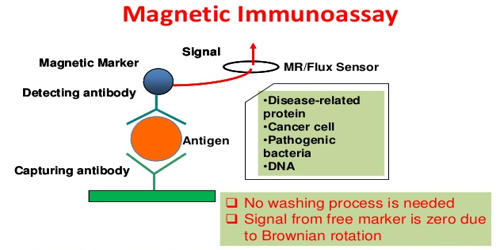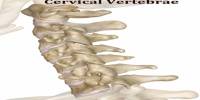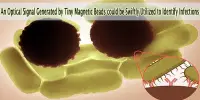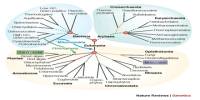Magnetic immunoassay (MIA) is a novel type of diagnostic immunoassay using magnetic beads as labels in lieu of conventional enzymes (ELISA), radioisotopes (RIA), or fluorescent moieties (fluorescent immunoassays) to detect a specified analyte. MIA can have many variants of modifications, similar to the classic immunoenzymatic assay.
MIA involves the specific binding of an antibody to its antigen, where a magnetic label is conjugated to one element of the pair.
Magnetic immunoassay should be considered as an evolutionary extension of the classical immunoassay. The presence of magnetic beads is then detected by a magnetic reader (magnetometer) which measures the magnetic field change induced by the beads. The signal measured by the magnetometer is proportional to the analyte (virus, toxin, bacteria, cardiac marker, etc.) concentration in the initial sample.
Detection
Magnetic Immunoassay (MIA) is able to detect select molecules or pathogens through the use of a magnetically tagged antibody. Functioning in a way similar to that of an ELISA or Western Blot, a two-antibody binding process is used to determine concentrations of analytes. MIA uses antibodies that are coating a magnetic bead. These anti-bodies directly bind to the desired pathogen or molecule and the magnetic signal given off the bound beads is read using a magnetometer. Magnetic particles may function, and this is important for immunoassay.
The largest benefit this technology provides for immunostaining is that it can be conducted in a liquid medium, where methods such as ELISA or Western Blotting require a stationary medium for the desired target to bind to before the secondary antibody is able to be applied. Directions and prospects of the development of methods of magnetic immunoassay are determined, mainly, by the development of methods for detecting or influencing magnetic particles.
Uses
MIA is a versatile technique that can be used for a wide variety of practices. The key distinctive element of the MIA is the use of magnetic particles (MPs), which are usually nanoparticles.
Currently, it has been used to detect viruses in plants to catch pathogens that would normally devastate crops such as the Grapevine fanleaf virus, Tabacco mosaic virus, and Potato virus X. The current trend is to combine or integrate the application of various biochemical, physical, molecular and genetic, Physico-chemical detection methods. Its adaptations now include portable devices that allow the user to gather sensitive data in the field.
MIA can also be used to monitor therapeutic drugs. In fact, all of these benefits undoubtedly open up broad prospects for the practical application of MIA in biology, biotechnology, and medicine. A case report of a 53-year old kidney transplant patient details how the doctors were able to alter the quantities of the therapeutic drug the man was
















